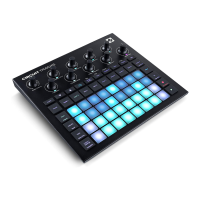30 31
Scales
Circuit Tracks is extremely flexible in how it lets you configure the note pads in the playing grid to
suit different musical ideas in both key and scale. There are two aspects to specifying how the note
pads are laid out: the scale and the root note.
Up to 16 musical scales are available: these include those common in western musical styles such
as major, natural minor, pentatonic and chromatic as well as more unusual scales (or modes) such as
Dorian, Lydian and Mixolydian. Not all these scales contain eight notes, though the only one that
has more than eight is Chromatic, with 12.
You don’t need to understand musical theory to make use of different scales. Because
Circuit Tracks lets you alter the scale in use after you’ve created a pattern, it’s easy to get
an idea of their effect and their differences. Record a simple pattern of synth notes, and
then play it back using different scales. You’ll notice that with some scales certain notes shift up or
down a semitone, and that this gives the “melody” you’ve composed quite distinct “moods” or
“feels”, some of which will be more suited to what you’re trying to achieve than others.
Furthermore, although the default keyboard is based on a note of C (as described in the previous
section), it is possible to redefine the lowest sounding note to be any note of the chosen scale.
Both scale and root note are set using the Scales View, accessed by pressing the Scales button
9
.
The Scales View will look similar to that shown below:
25 26 27 28 29 30 31 32
17 18 19 20 21 22 23 24
9 10 11 12 13 14 15 16
1 2 3 4 5 6 7 8
C
D#
B
A#G#
G
F#
FE AD
C#
Currently-selected
starting note
Currently-selected
scale
Keynote selection
Scale selection
NATURAL
MINOR
MAJOR DORIAN PHRYGIAN MIXOLYDIAN
MELODIC
MINOR
HARMONIC
MINOR
BEBOP
DORIAN
BLUES
MINOR
PENTATONIC
HUNGARIAN
MINOR
UKRANIAN
DORIAN
MARVA TODI
WHOLE
TONE
CHROMATIC

